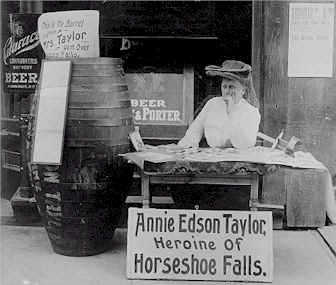"Agile-Waterfall": Doing flips over Niagara
October 24th 1901 Annie Taylor was the first person to conquer the falls in a barrel. After climbing inside her airtight wooden barrel, the air pressure was compressed to 30 p.s.i. with a bicycle pump.
After the experience Annie described how it helped to go down 10 meters, turn, go back up, then down, flip, then stop midair, think about it and realize she forgot her barrel, then she went to the top, got in the barrel, and then went down again, stopping periodically to check and see if everything was alright.
"...she would fall straight down at the same velocity."
Absurd? Well, then why is there a thing called "Agile-Waterfall Methodology" (AWM)? Isn't it just as absurd? In reality, if Annie attempted the above, she would have been trying to talk, stop, go up, but in the end she would fall straight down at the same velocity.
"Ever feel like these meetings produce zero action?"
Well, in AWM we do the same thing. We are always falling to the bottom with gravity pulling the project to completion. This is the scenario of AWM:
We're falling in the waterfall. If we want to stop, we have to change gravity (change the plan), and then fight the water pushing down (pressure from management). Both are nearly impossible in the paradigm of Waterfall.
In reality, we are performing an elaborate show with "sprint " and "planning meetings". Ever feel like these meetings produce zero action? AWM is the TSA of product development (See: security theater and this book). Do you feel like you're flapping your arms while falling down a cliff? "We should change this, but we can't afford a delay." "We need this done first, but it won't be done for another month." "Good meeting!" :|
Let's define Waterfall and Agile:
"The waterfall model is a sequential (non-iterative) design process, used in software development processes, in which progress is seen as flowing steadily downwards (like a waterfall) through the phases of conception, initiation, analysis, design, construction, testing, production/implementation and maintenance.
"What Is Agile? Not a methodology! The Agile movement seeks alternatives to traditional project management. Agile approaches help teams respond to unpredictability through incremental, iterative work cadences and empirical feedback. Agilists propose alternatives to waterfall, or traditional sequential development.
(Source: http://agilemethodology.org/)"
Notice the "non-iterative" and "iterative" parts of these definitions? In fact if you look at the definition of Scrum it literally says, "An Alternative to Waterfall"!
"...you can do Waterfall with your head held up high..."
What did we learn as a kid? Be yourself. Waterfall is not useless and Agile Scrum is not perfect for every situation especially when heavy regulation is involved. Just accept the circumstances and do what is best suited for the project. If you don't believe in, or you haven't transitioned your organization to Agile, then state that clearly. Then you can do Waterfall with your head held up high and we'll see how it works out. Want to change? Can you change? If both answers are yes, then go all in. I bet the Death Star was built using Waterfall (hence the obvious fatal flaw). Still, it blew up some planets so it's got that going for it!
An Agile-Waterfall shop should just put up a sign "We're just playing games. Don't work here unless you are too."
An Agile-Waterfall shop should just put up a sign "We're just playing games. Don't work here unless you are too."



Comments
Post a Comment